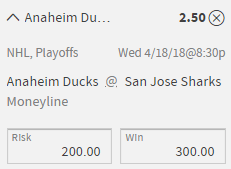Understanding odds is crucial when betting on sports. The odds are what dictate your risk vs reward on a wager, which is really what sports betting is when you get down to brass tacks.
There are three sports betting odds that you will generally see used online. These are American, decimal and fractional. The American odds format is the most commonly used here in the United States, but you will also surely see references to decimal or fractional odds used by various websites so it’s important to understand all three of these odds formats.
In the examples below I will be using odds from Bovada.lv, one of our recommended betting sites for Americans. Check out our full Bovada review here.
American Odds
The American odds format is the standard format used in the United States and likely the format that you are most familiar with. When you open a sports betting account the default setting will generally be the American odds format.
The American odds format involves a (-) or (+) in front of a number in the 100’s. A (-) indicates how much you would have to bet to win $100, while the (+) indicates how much you would win if you wagered $100.
Let’s look at a couple of examples:
In this example Colorado’s odds in the American format are +145. This means that a $100 bet on the Avalanche would win $145. In the above example I’ve used a $200 wager, which would win $290 (2 x 145 – aka double what you would win if you bet $100).
Now let’s look at the odds for the Predators.
Nashville is the favorite in this game and has odds of -165 to win. This means you would have to wager $165 to win $100. This is shown in the screenshot above where I entered a wager of $165 to show that the winnings would be $100.
The issue with the American odds format is that it’s difficult to calculate winnings in your head when betting on a favorite. Try to figure out the winnings of a $200 bet at the same odds of -165. It’s nearly impossible (the answer is $121.21).
That said, the American odds format is great for giving you a general idea of your potential winnings by either referencing how much you could win with a $100 wager, or how much you would have to wager to win $100.
Decimal Odds
The decimal odds format is the preferred odds format used everywhere outside of the United States. If you check the betting lines at a non-American sportsbook or odds service you will likely be shown odds in the decimal format. For this reason it’s important to understand decimal odds even if you generally use the American odds format when placing your personal wagers.
With the decimal odds format it’s quick and easy to calculate your potential payout based on the odds. A potential payout is the wager PLUS the winnings of the bet.
To find the potential payout you simply multiply your wager amount by the decimal odds associated with your pick. Here’s an example:
In this example I’ve taken the decimal odds for the Anaheim Ducks to win a game against the Sharks. The decimal odds of the Ducks winning the game are 2.50. To find the payout you simply multiply the wager amount by the decimal odds. So ($200 x 2.50) equals ($500). Then to find the winnings you would just subtract the wager amount ($500 – $200), leaving you with $300 in this example.
Fractional Odds
The last odds format that you will run into when betting online is the fractional odds format.
Fractional odds are generally used when there are several potential winners like in a horse race or a futures wager (to win the Super Bowl).
If the odds break down cleanly then fractional odds are very easy to understand. The numerator (the top number) is the amount you would win if you wagered the denominator (the bottom number). Here’s an example from the 2018 Kentucky Derby.
In this example a $100 bet on Justify would win $400 if he won the race. Similarly a $100 bet on Noble Indy would win $2000 (20/1) if he pulled off the upset.
Fractional odds are great when the denominator is 1. It’s when the fractional odds get all wonky like 11/4 or 20/27 that they become much more difficult to quickly understand.





